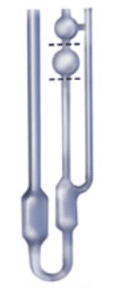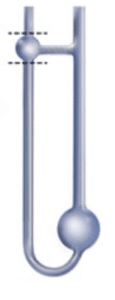How To Calculate Parenteral Product Viscosity Using The Capillary Viscometer Method
What is viscosity?
Viscosity is the amount of internal friction (or internal resistance) between components in a fluid. Honey is an everyday example of a highly viscous product. Products with high viscosity are considered “thick” and flow slowly. In contrast, water is an example of a fluid with low viscosity. Products with low viscosity are considered “thin” and flow quickly and easily. A fluid’s flow speed depends on how fast the molecules in a fluid can rearrange and move past each other. Thus, liquids with small molecules tend to have low viscosity. Liquids with long-chain molecules (such as hyaluronic acid) have higher viscosity. Also, liquids with molecules that can form bonds with each other are more viscous. The bonding of glucose and fructose in honey is why honey is so viscous.
What types of injectable products are viscous?
Viscous injectable formulations often have high concentrations of large molecules or non-aqueous solvents. Highly viscous formulations contain both. Examples of large molecules include monoclonal antibodies, proteoglycans, and high molecular weight polymers. Proteoglycans like hyaluronic acid are included in many cosmetic or parenteral products. Additionally, controlled release versions of parenteral formulations often include high molecular weight polymers. When it comes to non-aqueous solvents, oil-based product formulations tend to be the most viscous.
How is parenteral product viscosity calculated?
The United States Pharmacopeia offers three methods for viscosity determination. The first method is the viscosity-capillary viscometer approach (USP 911), which is the focus of this article. The second method is a rotational rheometer technique (USP 912). The rolling ball viscometer method (USP 913) is the third option for calculating viscosity.
How is viscosity calculated using the capillary viscometer method?
The capillary method is used to determine the viscosity of a Newtonian fluid (a liquid with a viscosity independent of the shearing stress or rate of shear). Capillary viscometer calculations are performed using suspended level capillary viscometers (Method 1) and Ostwald-type capillary viscometers (Method 2). Both methods are described in further detail below.

Method 1: Suspended-Level (Ubbelohde) Capillary Viscometer
Before testing, calibrate each viscometer at the test temperature by using fluids of known viscosities to determine the viscometer constant, k. A capillary viscometer is selected so that the flow time, t, is not less than two hundred seconds and the kinematic energy correction is less than 1%. For a capillary viscometer, the flow time of the fluid under examination is the mean of at least three consecutive measurements. The flow time is valid if the three readings’ relative standard deviation percentage (%RSD) is not more than 2.0%. To use a suspended-level viscometer, follow the manufacturer’s instructions to fill the viscometer’s tube with the sample. Immerse the vertical viscometer in a water or oil bath for at least thirty minutes to allow the temperature of the sample and equipment to reach equilibrium at the manufacturer-specified temperature. Then close the ventilation tube and raise the liquid level to about 8 mm above the highest distance marker (h1). Keep the liquid at this level by closing the tube parallel to the ventilation tube (N) and opening the ventilation tube. Next, open tube N and measure the time required for the liquid level to drop from mark (h1) to the lowest distance mark (h2).
To calculate the viscometer constant, k, in millimeters squared per second squared (mm2/s2):
k = η/(ρ x t)
Where:
η = known viscosity of the liquid in millipascals x seconds (mPa x s)
ρ = density of the liquid in grams per milliliter (g/mL)
t = flow time for the liquid to pass from the upper mark to the lower mark in seconds (s)
To calculate the kinematic viscosity, v, in mm2/s, from the viscosity constant and flow time:
v = k x t
Where:
k = viscometer constant (mm2/s2)
t = flow time for the liquid to pass from the upper mark to the lower mark in seconds (s)
If the density of the fluid is known (for the temperature at which the viscosity measurement is taken), Newtonian viscosity, η, in mPa x s, is calculated:
η = v x ρ
Where:
ρ = density of the fluid (g/mL)
v = kinematic viscosity (mm2/s)

Method 2: Simple U-Tube Capillary Viscometer (Ostwald-Type Viscometer)
To use a u-tube viscometer, fill the tube with your sample. The total sample fluid volume will ensure that the lower bulb is not entirely emptied when the fluid is drawn up through the capillary tube to the upper graduation mark. Next, the viscometer must undergo temperature equilibration. To do this, immerse the vertical viscometer in a water or oil bath at the manufacturer-specified temperature for thirty minutes. Then use suction to draw the fluid up through the capillary tube until the meniscus is at the level of the uppermost graduation. With both the filling and capillary tubes open to atmospheric pressure, record the time, in seconds, needed for the liquid to flow from the upper mark to the lower mark in the capillary tube. Like the suspended-level viscometer, the minimum flow time should be two hundred seconds.
Variables for a u-tube capillary viscometer are:
Line 1 = upper mark in the tube
V = given volume of fluid in meters cubed(m3)
Line 2 = lower mark in the tube
L = capillary tube length in meters (m)
Summary
Overall, viscous injectable formulations often have high concentrations of large molecules or non-aqueous solvents. With large protein biologics popularizing the drug therapy market, viscosity calculations for viscous products are essential for determining delivery mechanisms and accurately filling parenteral products. The capillary viscometer method is one of three methods described in the United States Pharmacopeia for determining viscosity. All in all, when filling a thick parenteral or cosmetic product, ensure you choose a contract manufacturing organization to support your sterile filling needs.
MycoScience is a contract manufacturing organization specializing in sterile syringe and vial filling. MycoScience also offers Preservative Efficacy Testing, Sterilization Validations, Bioburden Testing, Cleaning Validations, Microbial Aerosol Challenge Testing, Accelerated Aging, Microbiology Testing, Cytotoxicity Testing, Bacterial Endotoxin Testing, EO Residual Testing, Package Integrity Testing & Environmental Monitoring services medical devices and allied industries. MycoScience is an ISO 13485 certified facility.
References
Michael J. Akers. Sterile Drug Products Formulation, Packaging, Manufacture, and Quality. Drugs and the Pharmaceutical Sciences. Informa Healthcare. 2010.
Andrew Donnelly. Injecting High Viscosity Drugs: Challenges and Solutions. Bespak.com
Andy Fry. Injecting Highly Viscous Drugs. Pharmaceutical Technology. 2021.
United States Pharmacopeial Convention. <911>. Viscosity- Capillary Methods. Rockville, MD, USA. 2021. (USPC <911>)
Sharing this in your social netwroks

